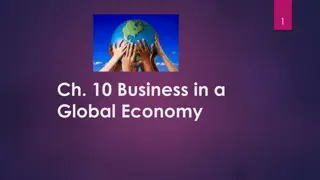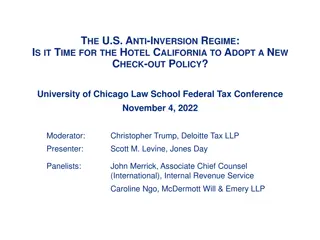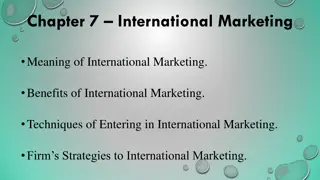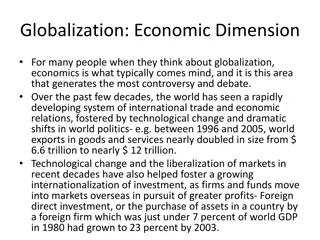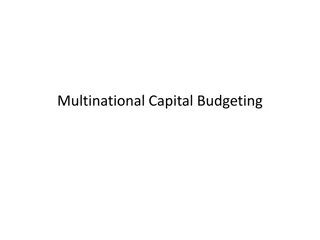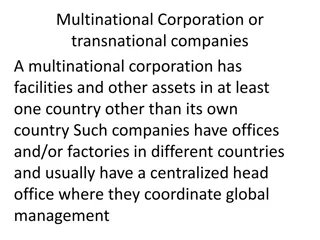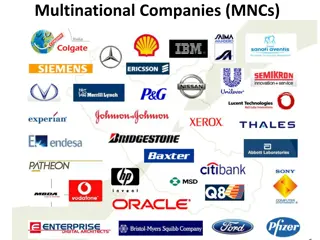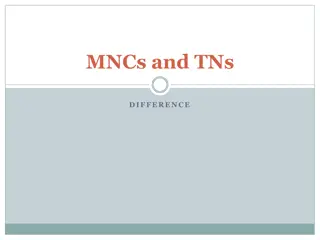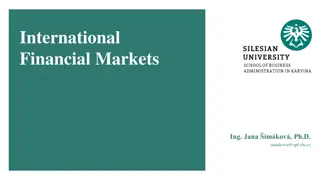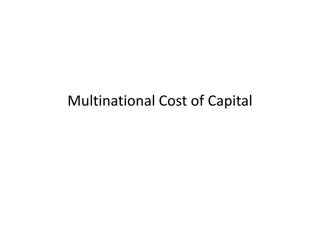Multinational Corporations
Multinational corporations (MNCs) are corporate organizations that own or control production of goods or services in multiple countries. They have a significant impact on global trade and economies, often deriving a substantial portion of their revenue from operations outside their home country. The history of MNCs is closely tied to colonialism, with many early corporations established for colonial expeditions. These corporations played a key role in international trade, exploration, and colonization, contributing to differential economic outcomes between home countries and colonies. The operations of MNCs have evolved over time, leading to different types of multinational structures such as decentralized, global, international, and transnational enterprises.
Download Presentation

Please find below an Image/Link to download the presentation.
The content on the website is provided AS IS for your information and personal use only. It may not be sold, licensed, or shared on other websites without obtaining consent from the author.If you encounter any issues during the download, it is possible that the publisher has removed the file from their server.
You are allowed to download the files provided on this website for personal or commercial use, subject to the condition that they are used lawfully. All files are the property of their respective owners.
The content on the website is provided AS IS for your information and personal use only. It may not be sold, licensed, or shared on other websites without obtaining consent from the author.
E N D
Presentation Transcript
MNC Dr. H. Deb Barma Assistant Professor Women s College, Agartala
MNC A multinational corporation or worldwide enterprise[1]is a corporate organization that owns or controls production of goods or services in two or more countries other than their home country.[ A multinational corporation can also be referred to as an multinational enterprise (MNE), an international corporation, a transnational corporation, or a stateless corporation.[3]There are subtle but real differences between these three labels, as well as those labels of multinational corporation and a worldwide enterprise.
An enterprise operating in several countries but managed from one (home) country. Generally, any company or group that derives a quarter of its revenue from operations outside of its home country is considered a multinational corporation. There are four categories of multinational corporations: (1) a multinational, decentralized corporation with strong home country presence, (2) a global, centralized corporation that acquires cost advantage through centralized production wherever cheaper resources are available, (3) an international company that builds on the parent corporation's technology or R&D, or (4) a transnational enterprise that combines the previous three approaches.
According to UN data, some 35,000 companies have direct investment in foreign countries, and the largest 100 of them control about 40 percent of world trade.
HISTORY The history of multinational corporations is closely intertwined the history of colonialism, with the first multinational corporations founded to undertake colonial expeditions at the behest of their European monarchical patrons.[20]Prior to the era of New Imperialism, a majority European colonies not held by the Spanish and Portuguese crowns were administered by chartered multinational corporations. Examples of such corporations include the British East India Company,[22]the Swedish Africa Company, and the Hudson s Bay Company.[23]These early corporations facilitated colonialism by engaging in international trade and exploration, and creating colonial trading posts.[24] Many of these corporations, such as the South Australia Company and the Virginia Company, played a direct role in formal colonization by creating and maintaining settler colonies.[24]
Without exception these early corporations created differential economic outcomes between their home country and their colonies via a process of exploiting colonial resources and labour, and investing the resultant profits and net gain in the home country.[25] The end result of this process was the enrichment of the colonizer and the impoverishment of the colonized.[26] Some multinational corporations, such as the Royal African Company, were also responsible for the logistical component of the Atlantic slave trade,[27] maintaining the ships and ports required for this vast enterprise. During the 19th century formal corporate rule over colonial holdings largely gave way to state- controlled colonies,[28][29]however corporate control over colonial economic affairs persisted in a majority of colonies.[24][28]
During the process of decolonization the European colonial charter companies were disbanded,[24]with the final colonial corporation, the Mozambique Company, dissolving in 1972. However the economic impact of corporate colonial exploitation has proved to be lasting and far reaching,[30]with some commentators asserting that this impact is among the chief causes of contemporary global income inequality.[26] Contemporary critics of multinational corporations have charged that some present day multinational corporations follow the pattern of exploitation and differential wealth distribution established by the now defunct colonial charter corporations, particularly with regards to corporations based in the developed world that operate resource extraction enterprises in the developing world,[31] such as Royal Dutch Shell, and Barrick Gold. Some of these critics argue that the operations of multinational corporations in the developing world take place within the broader context of neocolonialism.[32] However, multinational corporations from emerging markets are playing an ever-greater role, increasingly impacting the global economy.[
ADVANTAGES AND DISADVANTAGES Multinational Corporations no doubt, carryout business with the ultimate object of profit making like any other domestic company. According to ILO report "for some, the multinational companies are an invaluable dynamic force and instrument for wider distribution of capital, technology and employment; for others they are monsters which our present institutions, national or international, cannot adequately control, a law to themselves with no reasonable concept, the public interest or social policy can accept. MNC's directly and indirectly help both the home country and the host country.
ADVANTAGES OF MNC'S FOR THE HOST COUNTRY MNC's help the host country in the following ways 1. The investment level, employment level, and income level of the host country increases due to the operation of MNC's. 2. The industries of host country get latest technology from foreign countries through MNC's. 3. The host country's business also gets management expertise from MNC's. 4. The domestic traders and market intermediaries of the host country gets increased business from the operation of MNC's. 5. MNC's break protectionalism, curb local monopolies, create competition among domestic companies and thus enhance their competitiveness. 6. Domestic industries can make use of R and D outcomes of MNC's. 7. The host country can reduce imports and increase exports due to goods produced by MNC's in the host country. This helps to improve balance of payment. 8. Level of industrial and economic development increases due to the growth of MNC's in the host country.
ADVANTAGES OF MNC'S FOR THE HOME COUNTRY MNC's home country has the following advantages. 1. MNC's create opportunities for marketing the products produced in the home country throughout the world. 2. They create employment opportunities to the people of home country both at home and abroad. 3. It gives a boost to the industrial activities of home country. 4. MNC's help to maintain favourable balance of payment of the home country in the long run. 5. Home country can also get the benefit of foreign culture brought by MNC's.
DISADVANTAGES OF MNC'S FOR THE HOST COUNTRY 1. MNC's may transfer technology which has become outdated in the home country. 2. As MNC's do not operate within the national autonomy, they may pose a threat to the economic and political sovereignty of host countries. 3. MNC's may kill the domestic industry by monpolising the host country's market. 4. In order to make profit, MNC's may use natural resources of the home country indiscriminately and cause depletion of the resources. 5. A large sums of money flows to foreign countries in terms of payments towards profits, dividends and royalty.
DISADVANTAGES OF MNC'S FOR THE HOME COUNTRY 1. MNC's transfer the capital from the home country to various host countries causing unfavourable balance of payment. 2. MNC's may not create employment opportunities to the people of home country if it adopts geocentric approach. 3. As investments in foreign countries is more profitable, MNC's may neglect the home countries industrial and economic development.
APPLICABILITY TO PARTICULAR BUSINESS MNC's is suitable in the following cases. 1. Where the Government wants to avail of foreign technology and foreign capital e.g. Maruti Udyog Limited, Hind lever, Philips, HP, Honeywell etc. 2. Where it is desirable in the national interest to increase employment opportunities in the country e.g., Hindustan Lever. 3. Where foreign management expertise is needed e.g. Honeywell, Samsung, LG Electronics etc. 4. Where it is desirable to diversify activities into untapped and priority areas like core and infrastructure industries, e.g. ITC is more acceptable to Indians L&T etc. 5. Pharmaceutical industries e.g. Glaxo, Bayer etc.
THE INDIAN MULTINATIONAL India Inc. is flying high. Not only over the Indian sky. Many Indian firms have slowly and surely embarked on the global path and lead to the emergence of the Indian multinational companies. With each passing day, Indian businesses are acquiring companies abroad, becoming world-popular suppliers and are recruiting staff cutting across nationalities. While an Asian Paints is painting the world red, Tata is rolling out Indicas from Birmingham and Sundram Fasteners nails home the fact that the Indian company is an entity to be reckoned with. Some instances: Tata Motors sells its passenger-car Indica in the UK through a marketing alliance with Rover and has acquired a Daewoo Commercial Vehicles unit giving it access to markets in Korea and China. Ranbaxy is the ninth largest generics company in the world. An impressive 76 percent of its revenues come from overseas. Dr Reddy's Laboratories became the first Asia Pacific pharmaceutical company outside Japan to list on the New York Stock Exchange in 2001. Asian Paints is among the 10 largest decorative paints makers in the world and has manufacturing facilities across 24 countries.
Small auto components company Bharat Forge is now the world's second largest forgings maker. It became the world's second largest forgings manufacturer after acquiring Carl Dan Peddinghaus a German forgings company last year. Its workforce includes Japanese, German, American and Chinese people. It has 31 customers across the world and only 31 percent of its turnover comes from India. Essel Propack is the world's largest manufacturers of lamitubes - tubes used to package toothpaste. It has 17 plants spread across 11 countries and a turnover of Rs 609.2 crore for the year ended December 2003. The company commands a staggering 30 percent of the 12.8 billion- units global tubes market. About 80 percent of revenues for Tata Consultancy Services comes from outside India. This month, it raised Rs 54.2 billion ($1.17 billion) in Asia's second-biggest tech IPO this year and India's largest IPO ever. Infosys has 25,634 employees including 600 from 33 nationalities other than Indian. It has 30 marketing offices across the world and 26 global software development centres in the US, Canada, Australia, the UK and Japan. Sundram Fasteners is not merely a nuts and bolts company. It believes in thinking out of the box. Probably that is why it decided to acquire a plant in China. The plant in Jiaxin city in the Haiyan economic zone has ensured one fact: that its customers who were earlier buying Sundram products in Europe and the US, did not have to go far from home to access the product.
While the world was busy lauding the success of the fast-growing IT and services sector over the past few years, it did not notice the coming-of- age of the old economy brick and mortar businesses. Passenger car exports have nearly trebled in the past four years, from 28,122 units in 1998-99 to 1,30,000 units in 2003-04. Revenue from the export of passenger cars shot up 47.85 percent during April-May 2004- 05 to Rs 7.16 billion from Rs 4.84 billion in the same period last year. Exports of two and three wheelers have crossed the 300,000 mark for the first time clocking around 3,33,000. By 2005, the industry expects 400,000 two-wheelers on foreign shores. Commercial vehicle exports have also increased to an all time high of over 17,000. In percentage terms the growth during the year over the previous year have been almost 80 percent for passenger vehicles, over 49 percent for two and three wheelers and over 40 percent for commercial vehicles. India's export of auto components crossed the $ 1 billion mark in 2003- 04. By March 2003, $850 million worth of the nuts and bolts were exported, up from $578 million in March 2002. Bharat Forge has grown from a turnover of Rs. 519 crore in 1997-98 to Rs 1,500 crore in 2003-2004. Its 53-year-old chairman and managing director Baba Kalyani says: "We are today the most profitable forgings company in the world and the Germans respect that. Today, we are not viewed as a company from the Third World ruling over a German firm."
Vedanta Resources, the holding company of the Sterlite group raised a record $1 billion last year in its maiden public offering on the London Stock Exchange (LSE). This was the largest sum garnered by an Indian company in overseas markets and the second largest IPO in Europe in 2003. In 2003-04, nearly Rs 2,500 crore of the total turnover of Hindalco - Rs 1,800 crore from copper and rs 620 crore from aluminium - came from the international business, including exports from India. Another space which is seeing hectic activity is the pharma sector. Ranbaxy has set an aggressive target for itself - to become a $5 billion company by 2012. That would require a compounded annual growth rate in excess of 20 percent. Going by its present growth strategies, that goal should not be far away. The firm exports to over 70 countries, directly manages operations in 34 and manufactures in seven. It has 8,500 employees, of which 2,000 are overseas. In October last year, Ranbaxy entered into a research collaboration with GlaxoSmithKline Plc. This will be just another way in the company becoming a global player. Dr. Reddy's Labs, which is the second largest pharma company in the country, has operations in many countries with its markets being in US, India and CIS countries and the UK. US and India contribute close to 70 percent of its sales. Dr Reddy's boasts of six FDA-inspected API (active pharmaceutical ingredients, or bulk) facilities and seven formulation plants, three of which cater to the US and European markets. It is also the only Indian company to have ever out-licensed three molecules to MNCs.
Aurobindo Pharma is already part global with eight subsidiaries across the world, two JVs in the US and a new acquisition in China. Half of its revenues come from exports, which accounted for 47 percent of the total sales in 2002-2003. This strength is derived from its strong presence in emerging markets of Asia, Brazil and Latin America. It's not only the private sector that is in aggressive mode. Even public sector units are rearing their heads to join the global Indian takeover race though for different reasons. In the last two years, ONGC has become a valuable company with a market capitalization of Rs. 122,000 crore. Now it wants to build bigger energy assets, both in India and abroad. The reasons IOC has for going global are, in comparison, more market-driven. Its chairman M.S. Ramachandran feels that Southeast Asia and Africa offers great opportunities for the corporation. In fact, the number of acquisitions abroad has increased considerably in the past few years. Indian multinationals appear to be on a shopping spree. They have acquired 120 foreign firms between 2001-03 for a consolidated amount of $1.6 billion and are now in the process of expanding their mergers and acquisition activities to Spain, Brazil, the rest of South America and Europe.
INDIAN PRODUCTS SOLD IN THE NAME OF THE MULTI-NATIONAL COMPANIES It is said that the M.N.C will bring money with them. They will bring technology with them and help in the development of our country. Because of this only today Indians are in the hands of the foreign companies. Below some of the companies are given which did not bring money with them, did not bring technology with them or did not put a factory. But products sell in their name and they still earn cores of money.
REFERENCE http://www.freedomindia.com/indian/indian_products.html https://www.ibef.org/pages/indianmncs










